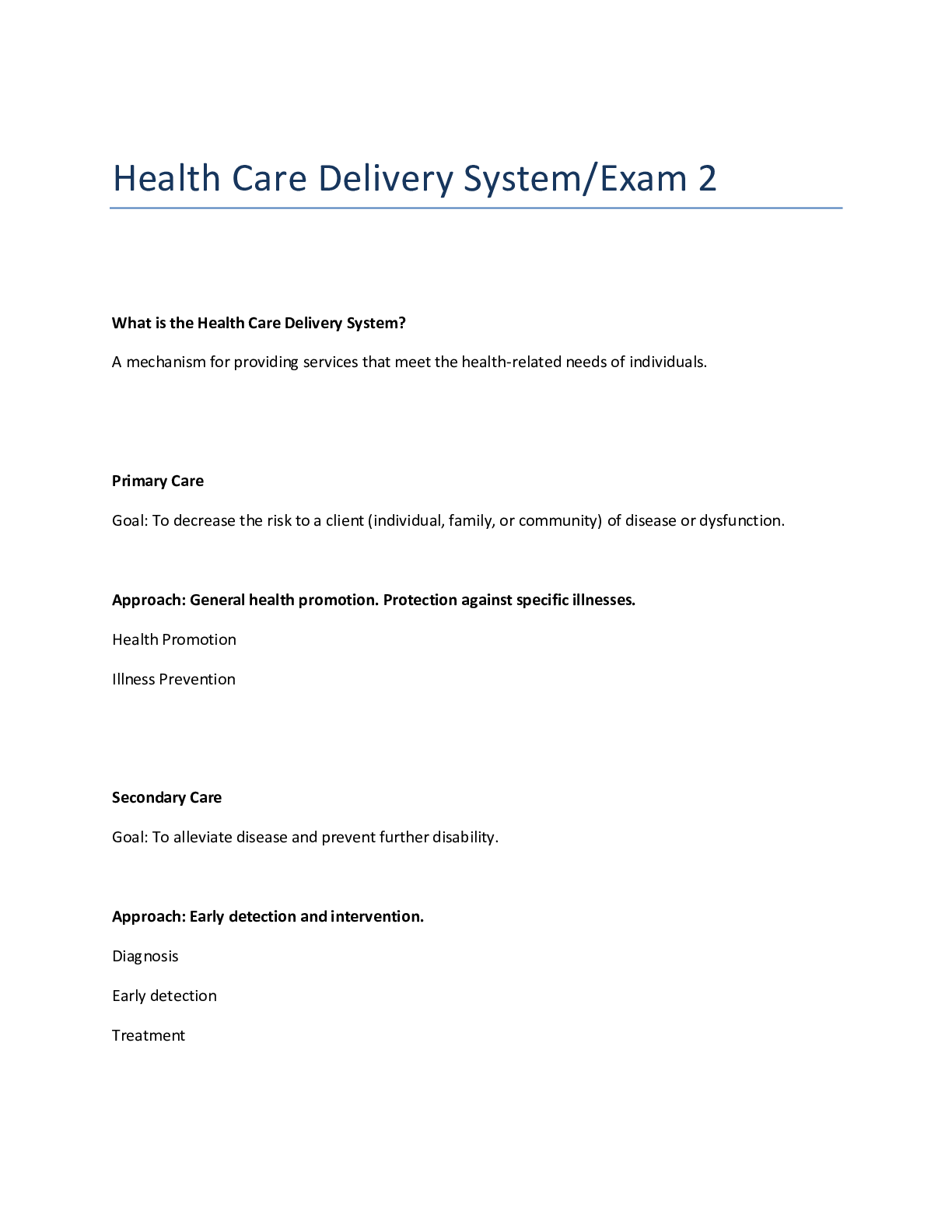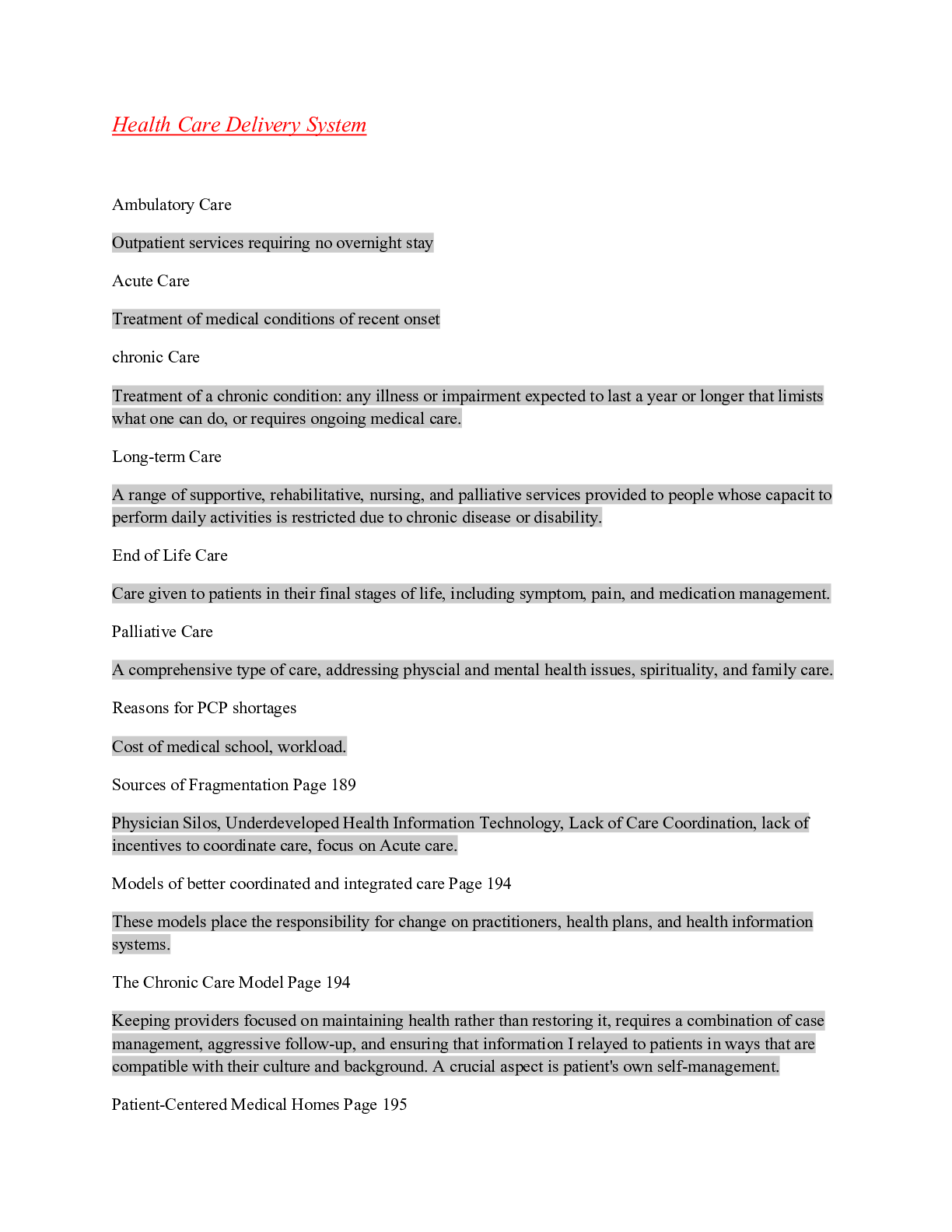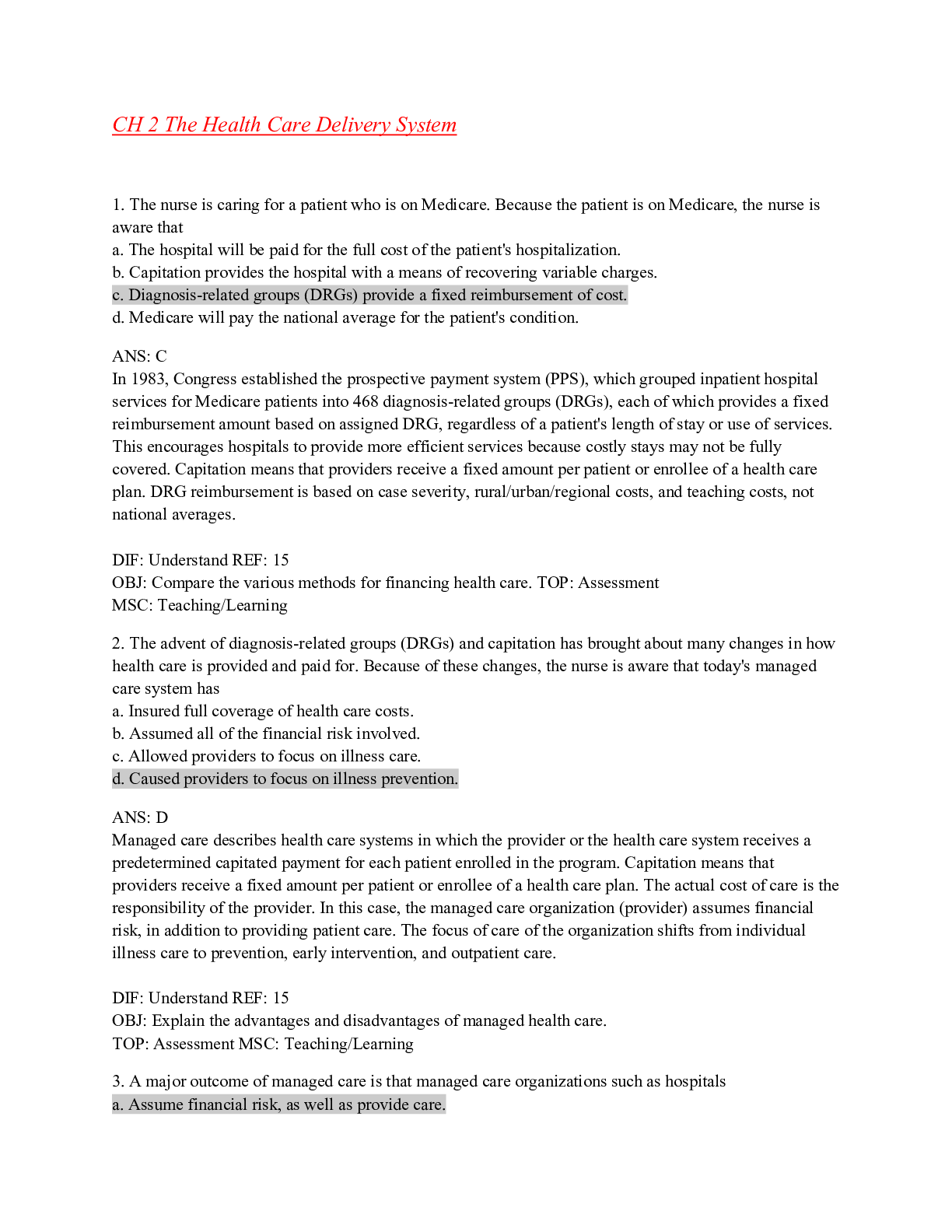Health Care > EXAM > Health Care Delivery System Exam Study Guide. Latest (All)
Health Care Delivery System Exam Study Guide. Latest
Document Content and Description Below
Health Care Delivery System Exam Study Guide. Latest Health Care Delivery System Who is the biggest consumer of healthcare? The federal government Federal government pays for Medicare Medicai... d Professional Standards Review Organizations A program created by the federal government to review the quality, quantity, and cost of hospital care PSROs Professional Standards Review Organizations Utilization Review Committee -For medicare qualified hospitals. -They supervise physicians by reviewing the admissions, identify, and eliminate overuse of diagnostic and treatment services ordered by physicians caring for patient on medicare. UR Utilization Review Committee Prospective Payment System A program established by congress that eliminated cost based reimbursement. Hospitals were no longer able to bill what the patients care costs were. Instead, they are reimbursed a set amount of money based the diagnosis related groups they are placed in. PPS Prospective Payment System Diagnosis-related groups Groupings of inpatient hospital services for patients on medicare. These groupings dictate the amount reimbursed, regardless of their length of stay. DRGs Diagnosis-Related Groups Adjustments to DRGs reimbursement are based on -Case Severity -Rural/urban/regional costs -Teaching costs Caption payment The providers receive a fixed amount per patient or enrollee of a health care plan. Capitation payments are based on The best standards of care at the lowest price DRGs are normally used in: Rehabilitation Settings RUGs are normally used in Long-term care RUGs Resource utilization groups Managed Care Describes health care systems in which the provider or health care system receives a predetermined capitated payment for each patient enrolled in the program Characteristics of managed care systems -Provider receives a predetermined payment for each patient in the program -System tries to reduce cost keeping patients healthy -They focus on containing/reducing costs, increasing patient satisfaction, and improving the health or functional status of individuals -They also focus on prevention, early intervention, and outpatient care Government instituted programs designed to control the health care cost -Professional Standards Review Organization (PRSOs) -Prospective Payment Systems (PPS) -Diagnosis-related groups (DRGs) General difference between medicare and medicaid -Medicare is generally for people over 65, regardless of their income. -Medicaid is an assistance program for low income individuals -Medicare is federally ran -Medicaid is ran by the states -Medicaid patients generally don't have to pay -Medicare patients share the costs with the government Common issues facing health care delivery systems -Rising costs -Increased access to services -Growing Population -Improved quality of outcomes Today, the emphasis of the health care industry is Managing the health of a community and their environment, rather than managing illness. Health Services Pyramid is -A program developed by the Core Functions Project that ranks health care into different levels. -Achievements in the lower tiers contribute to the improvement of health care delivered by the higher tiers. Levels of the health services pyramid Health care's emphasis on wellness has led to improvements in -Sanitation and prevention of infectious diseases. -Patient teaching -Injury prevention programs A wellness perspective focuses on The health of a population and the communities in which they live, rather than just on finding a cure for an individual's disease Examples of ways in which a focus on wellness has lead to improvements in sanitation and prevention of infectious diseases -Water -Sewage -Immunizations -Improved living conditions How has wellness focused patient teachings lead to an improvement in health -Dietary habits -Decreased tobacco use -Blood pressure control Examples of injury prevention programs -Seat belt restraints -Child seats -Helmet laws SERVICES health care providers offer are classified as: -Primary -Secondary -Tertiary Health care SETTINGS in which providers care for patients are classified as -Preventative -Primary -Secondary -Tertiary -Restorative -Continuing Primary care is aka as Health Promotion Examples of primary care services -Prenatal and well-baby care -Nutrition Counseling -Family Planning -Exercise classes Examples of Preventive Care services -Blood pressure and cancer screening -Immunizations -Mental Health counseling and crisis prevention -Community legislation (e.g, seat belts, air bags, bike helmets) Examples of secondary acute care services -Emergency care -Acute medical-surgical care -Radiological procedures for acute problems (e.g x-rays, CT scans) Examples of tertiary care services -Intensive care -Subacute care Examples restorative care services -Cardiovascular and pulmonary rehabilitation -Sports medicine -Spinal cord injury programs -Home care Examples of continuing care services -Assisted living -Psychiatric and older adult day care Integrated deliver networks include A set of providers and services organized to deliver a continuum of care to a population of patients at a capitated cost in a particular setting IDNs Integrated Delivery Networks IDNs are found in Large health care systems Method of payment for health care systems with IDNs Capitated Benefits of an integrated system include Reducing duplication of services across levels or settings to ensure that patients receive care in the most appropriate setting Accreditations vs. certifications -Accreditations are awarded to the organization as a whole -Certifications are awarded to specific programs or services within the organization Primary health care focuses on Improved health outcomes for an entire population In order for primary health care to be successful, there must be Collaboration among health professionals, health care leaders, and community members Primary health care collaboration should be focused on -Improving health care equality -Making health care systems person centered -Developing reliable and accountable health care leaders -Promoting and protecting the health of communities Health promotion programs should end up lower overall costs by: -Reducing the incidence of disease -Minimizing complications -Reducing the need to use more expensive health care resources Preventive Care Focuses on reducing and controlling risk factors for disease through activities such as occupational health programs and immunizations Preventive and primary care services are offered thru -School Health -Occupational health -Physicians' offices -Nurse-managed clinics -Block and parish nursing -Community Health centers School health programs are Comprehensive programs that include health promotion principles throughout a school curriculum. They emphasize program management, interdisciplinary collaboration, and community health principles Services/programs available thru school health -Positive life skills -Nutritional planning -Health screening -Counseling -Communicable disease prevention -Crisis intervention Occupational Health Programs -Comprehensive programs designed for health promotion and accident or illness prevention in the work place setting. -It aims to increase worker productivity, decrease absenteeism, and reduce the use of expensive medical care Services/programs offered thru occupational health -Environmental surveillance -Physical Assessment -Health Screening -Health Education -Communicable disease control -Counseling Physicians offices provide -Primary health care (diagnosis and treatment) -Often focus on health promotion practices Programs/services offered thru physicians offices -Routine physical examination -Health screening -Diagnostics -Treatment of acute and chronic ailments Nurse managed clinics provide Nursing services with a focus on health promotion and educations, chronic diseases assessment management, and support for self care and caregivers Programs/services offered thru nurse managed clinics -Day care -Health Risk appraisal -Wellness Counseling -Employment readiness -Acute and chronic care management Block and parish nursing is -A program where nurses living within a neighborhood provides services to older patients or those unable to leave their homes. -Fills in gaps not available in traditional health care system Programs/services offered thru block and parish nursing -Running errands -Transportation -Respite Care -Homemaker aides -Spiritual health Community health centers -Outpatient clinics that provide primary care to a specific patient population (ex. well-baby, mental health, diabetes) that lives in a specific community -Often associated with a hospital, medical school, church, or some other community organization Programs/services offered thru the community health center -Physical assessment -Health screening -Disease management -Health education -Counseling Most common service (their focus) in secondary and tertiary care Diagnosis and treatment of illnesses What is the most common and expensive service of the health care delivery system Disease management Fastest growing age group of uninsured citizens is: Young adults between the ages of 19 and 34 Why are young adults the fastest growing age group of uninsured citizens? -Low income -Inability to attend college -Unable to find a job with health benefits People without health insurance typically Wait longer before they visit their doctor for treatment. This generally results in them getting sicker and needing more complex health care Secondary and tertiary care are considered to be Acute care Secondary and tertiary care settings Hospitals Intensive Care Psychiatric facilities Rural Hospitals Hospitals provide secondary and tertiary care thru the -Emergency department -Urgent care centers -Critical care units -Inpatient medical-surgical units The number of days patients can be expected to be hospitalized is limited based on their DRGs on admission Many hospitals have implemented a work redesign in order to Contain costs Because of work redesign: More services are available on nursing units. This will minimize the need to transfer and transport patients across multiple diagnostic and treatment settings The focus in hospitals is to Provide the highest quality of care possible so patients are discharged early but safely to home or another health care facility that will adequately manage remaining health care needs When does discharge planning begin The moment a patient is admitted to a health care facility. Discharge planning is a Centralized, coordinated, interdisciplinary process that ensures that the patient has a plan for continuing care after leaving a health care agency When do patients leave hospitals? As soon as their physical conditions will allow them to leave. Common continuing health care need for a patient who had a stroke when they leave the hospital is Ambulation training Common continuing health care need for a surgical patient when they leave the hospital is Wound care at the home How do nurses help in the discharge planning process? -They anticipate and identify patients continuing needs before the actual time of discharge -Coordinating health care team members in achieving an appropriate discharge plan Often times, effective discharge planning requires -Referrals to various health care disciplines -Often times these referrals must be ordered by the provider Before leaving the health care facility, the patient must know: -Safe and effective use of medications and medical equipment -Instructions in potential food-drug interactions and counseling on nutrition and modified diets -Rehabilitation techniques to support adaptation to and/or functional independence in the environment -Access to available and appropriate community resources -When and how to obtain further treatment -The patient's and family's responsibilities in the patient's ongoing health care needs and the knowledge and skills needed to carry out those responsibilities -When to notify their health care provider for changes in functioning or new symptoms What is the most expensive health care delivery site? Why? -The ICU -Because each nurse usually cares for only one or two patients at a time, and because ICU patients require complex treatments and procedures Psychiatric facilities are for Patients who suffer emotional and behavioral problems because they often require special counseling and treatment Example of patients that need to be treated by a psychiatric facility Patients with depression, violent behavior, and eating disorders Psychiatric facilities offer ______ and _____ services, depending on: -Inpatient -Outpatient -The seriousness of the problem Psychiatric patients are admitted to the facility ____ or ____ Voluntarily Involuntarily At discharge from inpatient facilities, patients usually receive: A referral for a follow up care at clinics or with counselors The change in designation for rural hospitals to critical access hospitals if certain criteria were met was brought on by The Balanced Budget Act of 1997 CAH Critical access hospitals What is the criteria that must be met for a rural hospital to become designated a CAH? -Must be located in a rural area -Must provide 24 hour emergency care -No more than 25 inpatient beds for providing temporary care for 96 hours or less to patients needing stabilization before transfer to a larger hospital CAH provides -Inpatient care to acutely ill or injured people before transferring them to better equipped facilities -Basic radiological and laboratory services Restorative care serves Patients recovering from an acute or chronic illness/disability Goals of restorative care are to Help individuals regain maximal functional status and enhance quality of life through promotion of independence and self care Why has the intensity of care increased in restorative care settings? Because patients are leaving the hospitals earlier A nurse should understand that the success of restorative care depends on Effective and early collaboration with patients and families In restorative care settings, patients and families require: -A clear understanding of goals for physical recovery -The rationale for any physical limitations -The purpose and potential risks associated with the therapy What happens when patients and families are involved in restorative care? They are more likely to follow treatment plans and achieve optimal functioning What are the different restorative care settings? -Home Health Care (Home Care) -Rehabilitation -Extended care facilities Home care is the Provision of medically related professional and paraprofessional services and equipment to patients and families in their homes for health maintenance, education, illness prevention, diagnosis and treatment of disease, palliation, and rehabilitation Services commonly provided by home health nurses -Wound care -Respiratory Care -Vital sign monitoring -Elimination needs (ostomy, skin care, irrigation, insertion of catheters, peritoneal dialysis) -Nutrition -Rehabilitation -Medication administration and education -IV therapy -Laboratory Studies Home care services coordinate -Access to and delivery of home health equipments or durable medical equipment. Durable medical equipment is Any medical product adapted for home use What are the traditionally the primary objectives of home care -Health promotion -Education The focus of rehabilitation is To restore patients to their fullest physical, mental, social, vocational, and economic potential Examples of when patients require rehabilitation -Stroke -Injury -Chemical addiction -Spinal cord injury -Sports injuries -Cardiac events Different rehabilitation settings -Hospital -Rehabilitation Centers -Outpatient settings -Homes Rehabilitation services include -Physical -Occupational -Speech therapy -Social services Ideally, rehabilitation begins When the patient enters a health care setting for treatment Most important part of rehabilitation is for patients and families to Adapt to the injury and illness Extended care facilities provide Intermediate medical, nursing, or custodial care for patients recovering from acute illness or those with chronic illnesses or disabilities Skilled nursing facility Offers skilled care from a licensed nursing staff Services offered at skilled nursing facilities -Administration of IV fluids -Wounds Care -Long term ventilator management -Physical Rehabilitiation Continuing care is for People who are disabled, functionally dependent, or suffering a terminal disease Continuing care settings -Nursing centers/facilities -Assisted living -Respite Care -Adult Day Care Centers -Hospice Nursing centers provide -24 hour intermediate and custodial care -Nursing, rehabilitation, diet, social, recreation, and religious services Nursing centers/facilities standards are regulated by The Omnibus Budget Reconciliation Act of 1987 OBRA Omnibus Budget Reconciliation Act Staff members must complete a _____ on all nursing center residents Resident Assessment Instrument RAI Resident assessment instrument The RAI consists of -The minimum dataset -Resident assessment protocols -Utilization guidelines of each state MDS Minimum dataset Major regulatory requirements defined by OBRA -Resident Rights -Admission, transfer, and discharge rights -Resident behavior and facility practices -Quality of life -Resident assessment -Quality of care -Nursing services -Dietary services -Physician services -Specialized rehabilitative services -Dental services -Pharmacy services -Infection control -Physical environment -Administration MDS consists of -Resident's background -Cognitive, communication/hearing, and vision patterns -Physical functioning and structural problems -Mood, behavior, and activity patterns -Psychosocial well being -Bowel and bladder continence -Health conditions -Disease diagnoses -Oral/nutritional and dental status -Skin condition -Medication use -Special treatments and procedures Assisted living offers Long term care setting with a home environment and greater resident autonomy Respite care is A service that provides short term relief or "time off" for people providing home care to an ill, disabled, or frail older adult. Adult day care centers provide A variety of health and social services to specific patient populations who live alone or with family in the community Hospice A system of family centered care that allow patients to live and remain at home with comfort, independence, and dignity while easing the [Show More]
Last updated: 1 year ago
Preview 1 out of 15 pages
Instant download
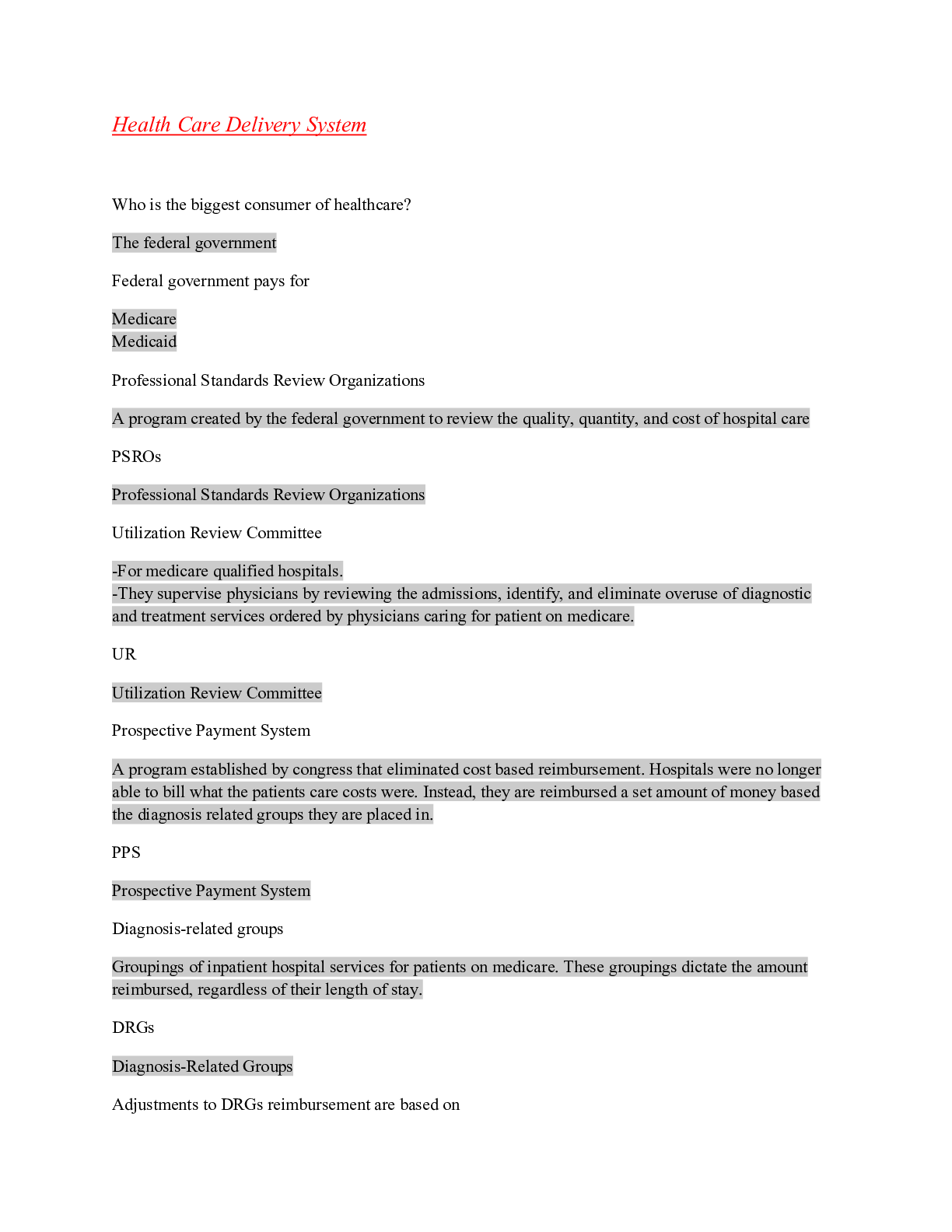
Buy this document to get the full access instantly
Instant Download Access after purchase
Add to cartInstant download
Reviews( 0 )
Document information
Connected school, study & course
About the document
Uploaded On
Nov 21, 2022
Number of pages
15
Written in
Additional information
This document has been written for:
Uploaded
Nov 21, 2022
Downloads
0
Views
22


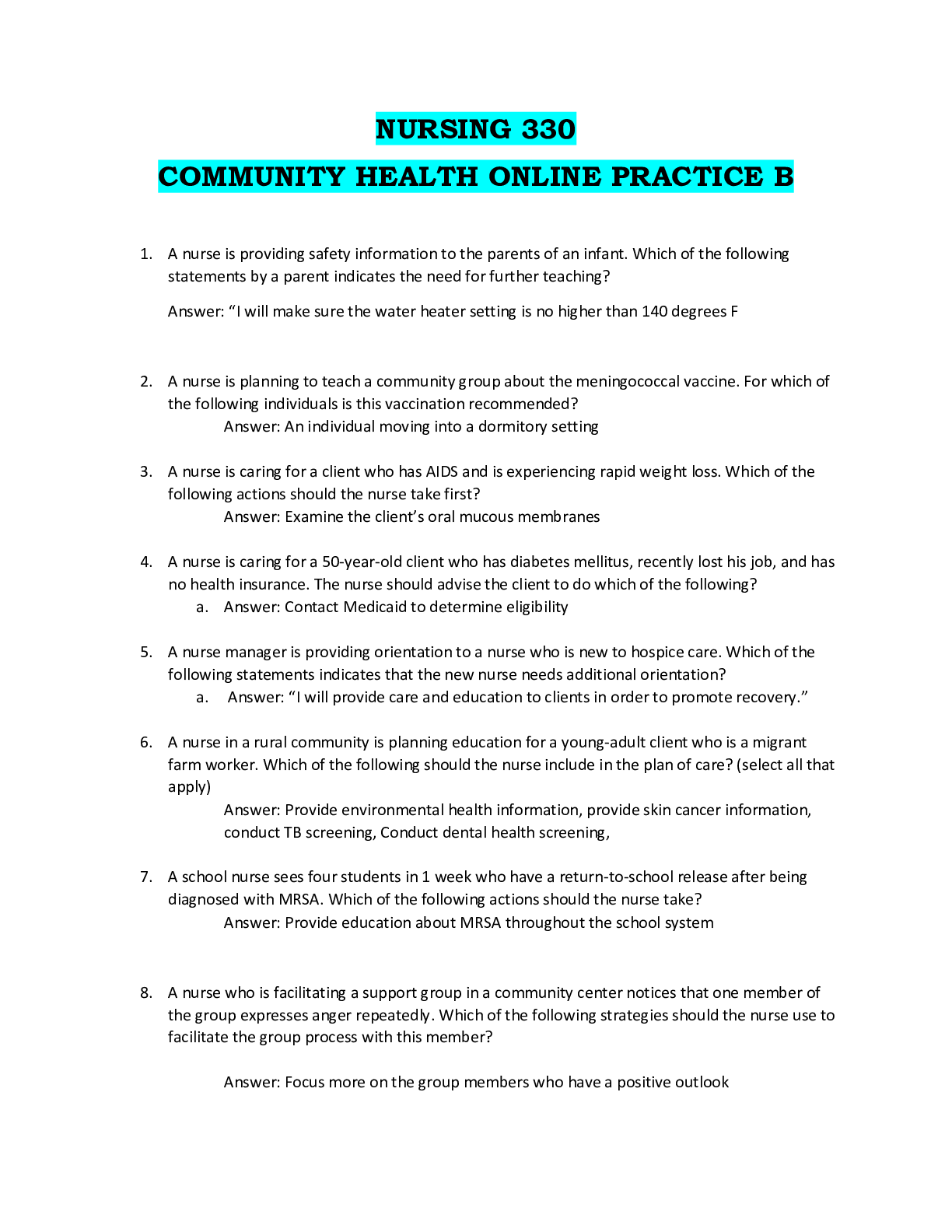
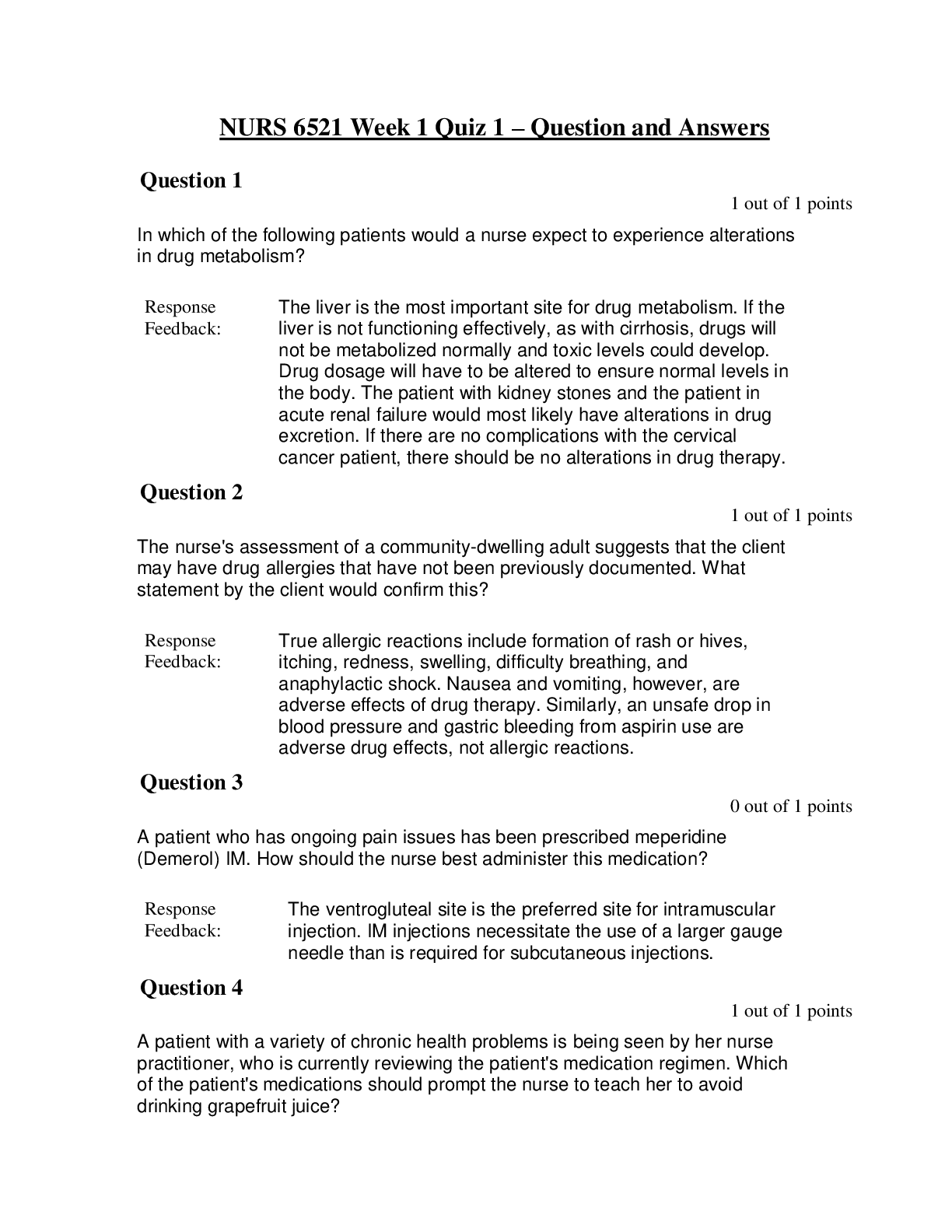




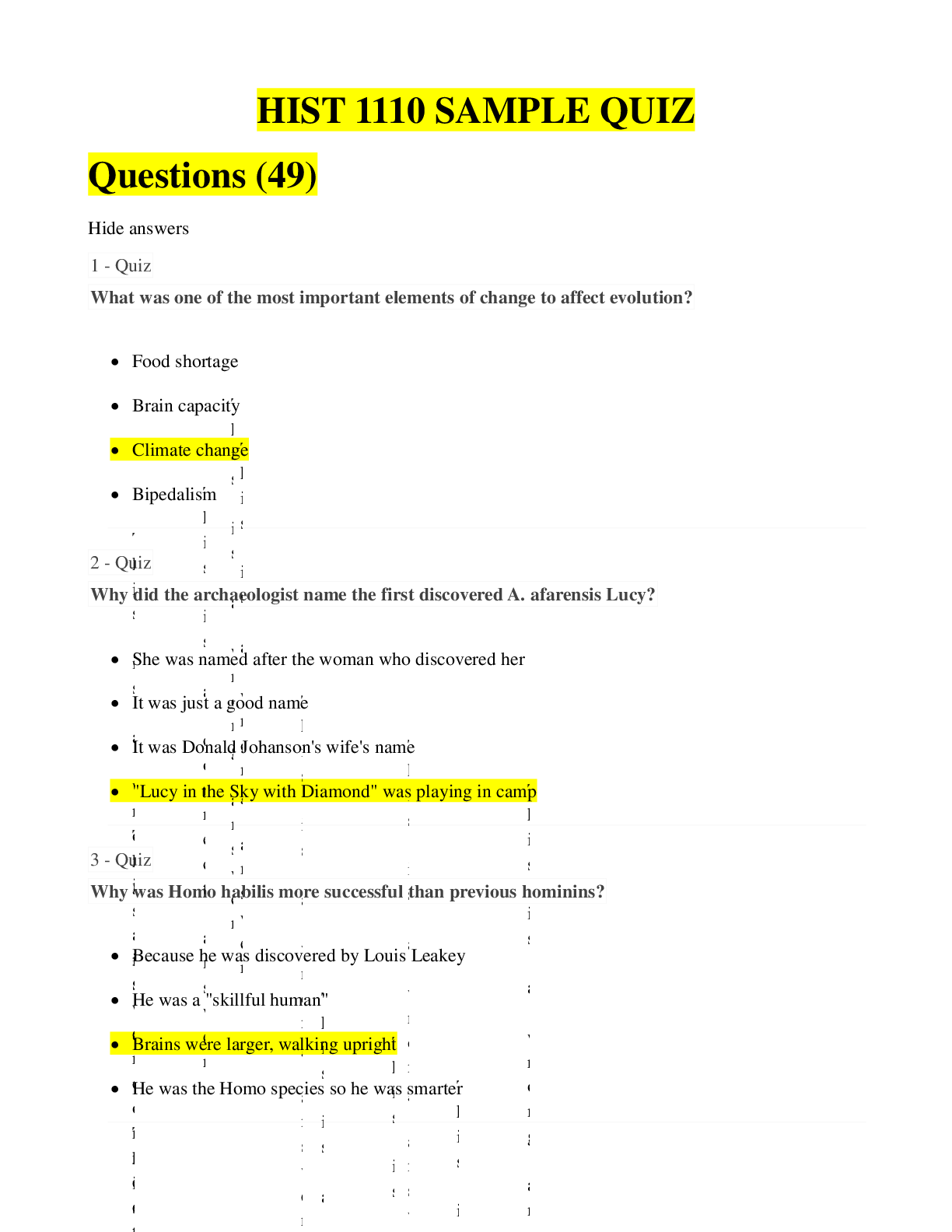
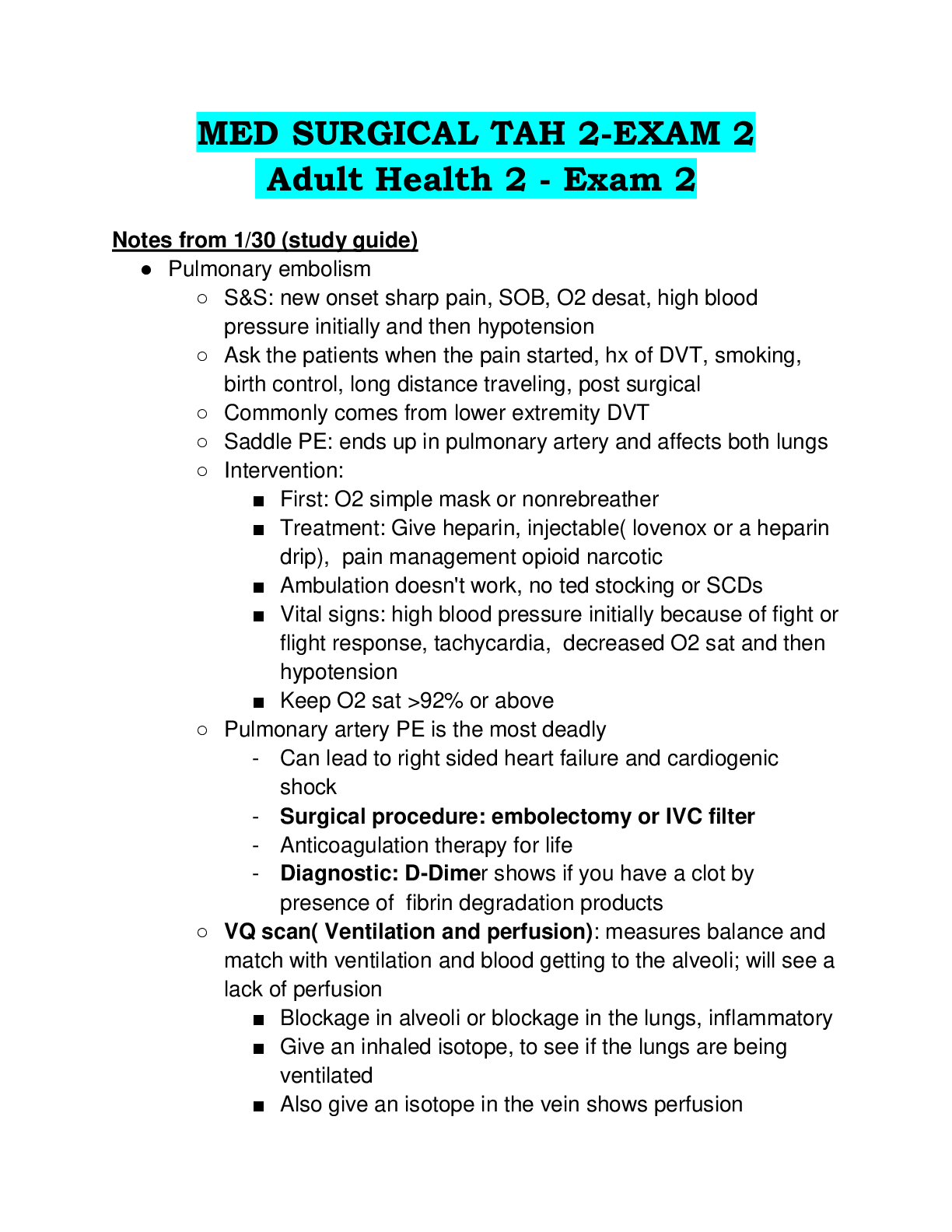

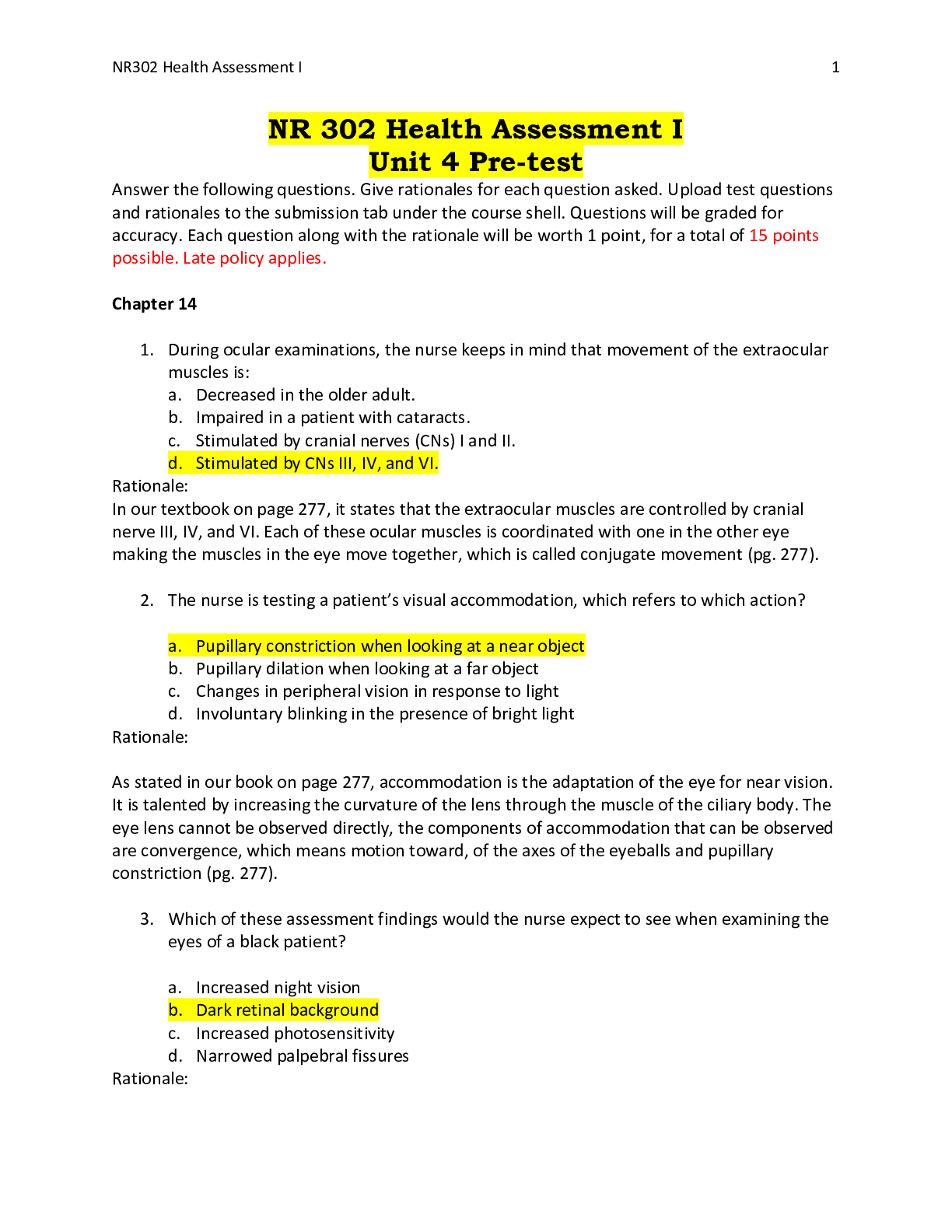


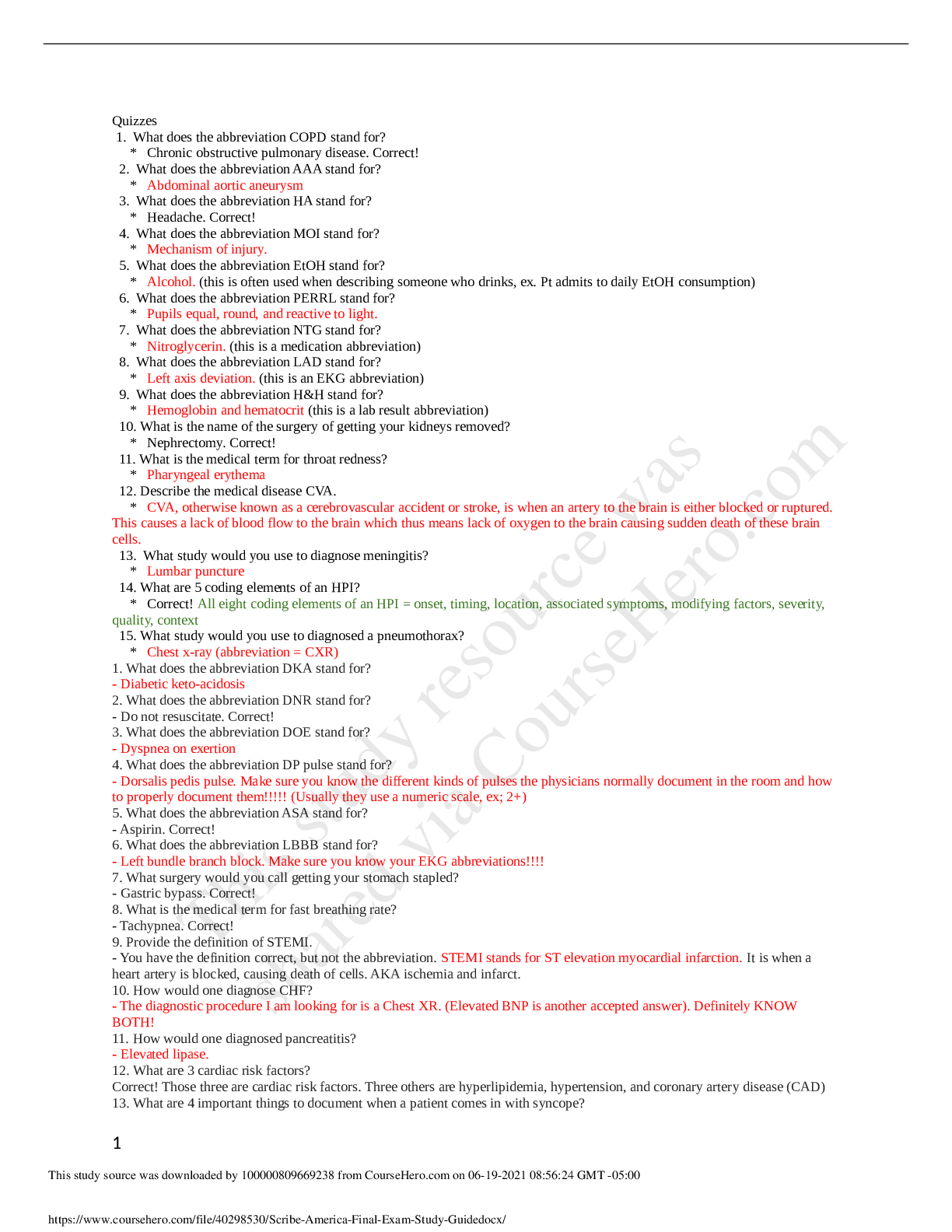
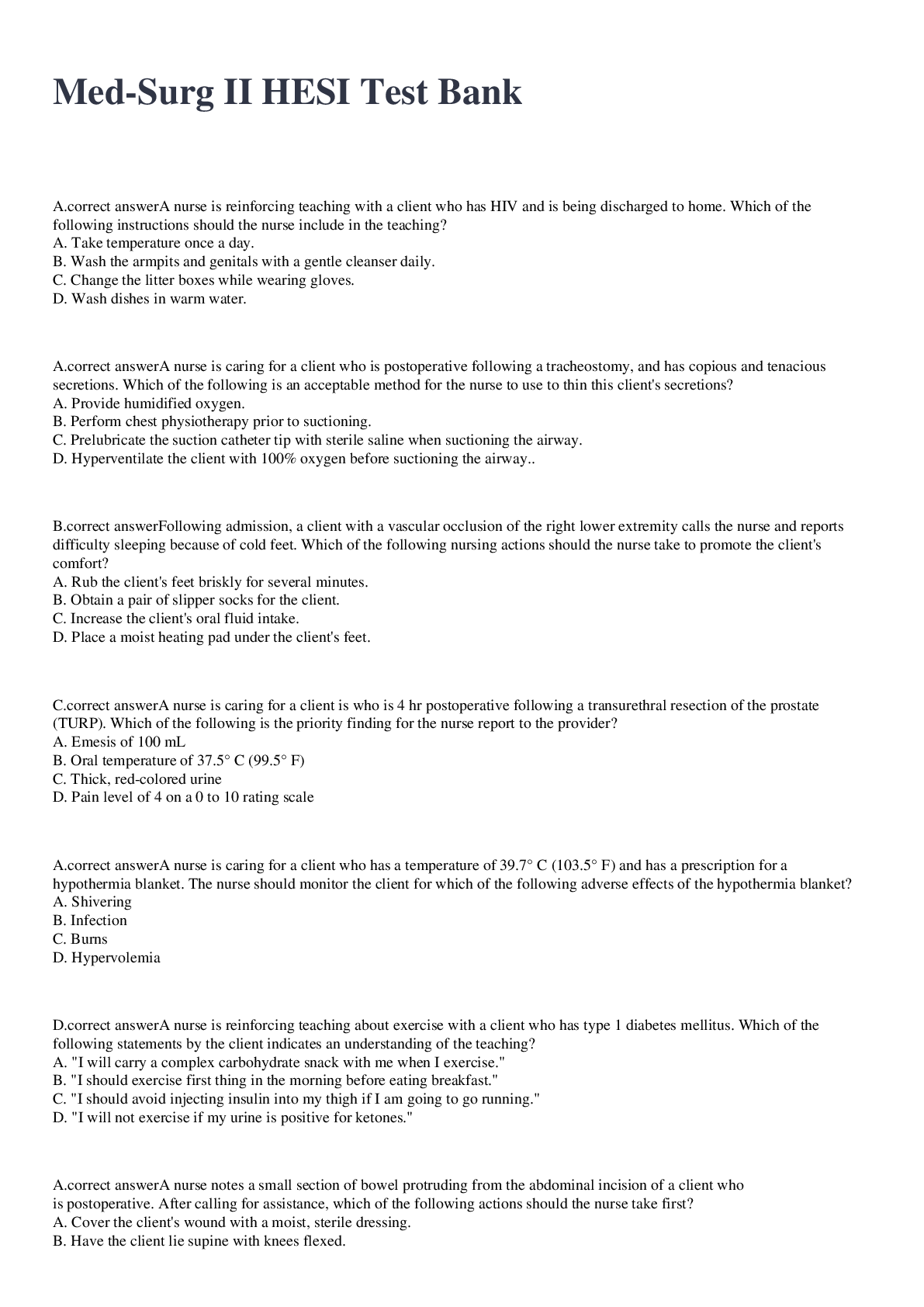

.png)

